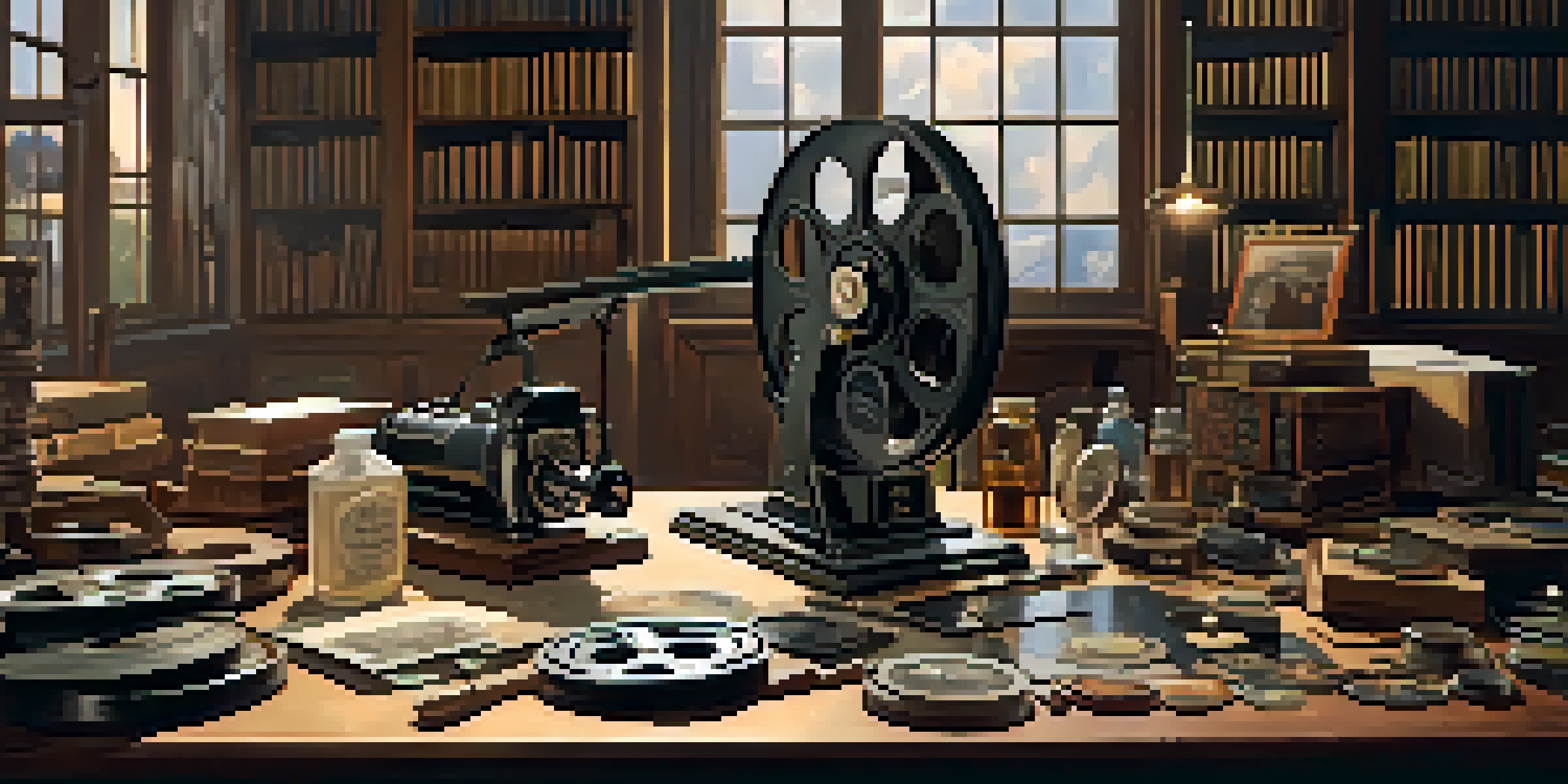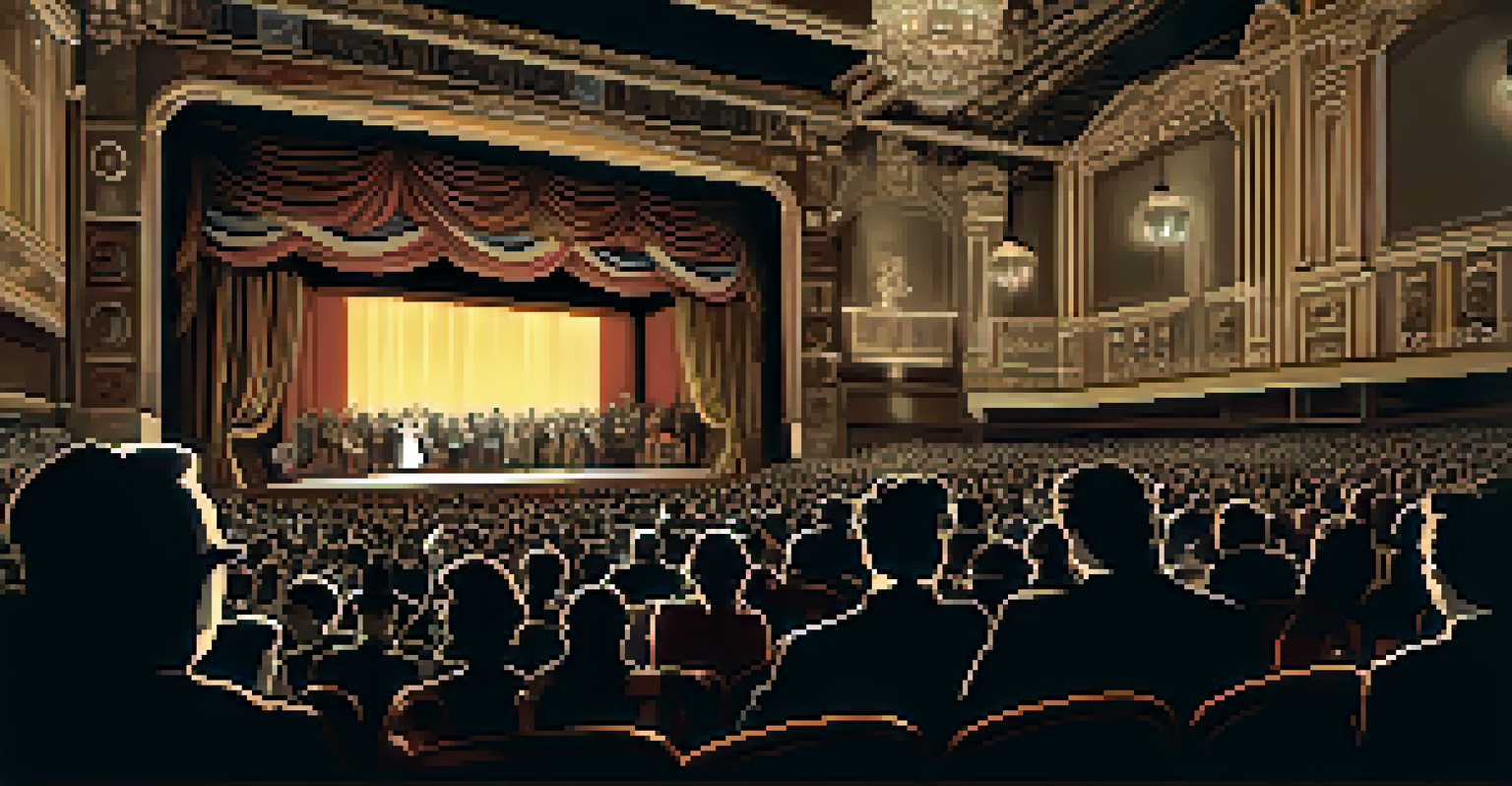Restoring Silent Films: Unique Challenges and Techniques

Understanding the Silent Film Era and Its Impact
Silent films, produced primarily between the late 19th and late 1920s, hold a unique place in cinematic history. They were revolutionary in their storytelling, relying heavily on visual cues and title cards. The absence of synchronized sound created a distinct viewing experience, making viewers rely on expressive acting and innovative cinematography. This era gave birth to iconic figures like Charlie Chaplin and Buster Keaton, whose performances remain timeless.
Silent films are like a bridge to the past, allowing us to glimpse the world as it was and to hear the echoes of laughter and emotion that once filled the theaters.
Despite their charm, many silent films are at risk of being lost forever due to degradation and neglect. The materials used in early filmmaking, such as nitrate film stock, are highly susceptible to decay. As a result, countless films from this era exist only in fragments or not at all. The challenge lies not only in finding these films but also in restoring them to their former glory for new generations to appreciate.
Restoring silent films is akin to archaeologists digging through layers of history. Each film tells a story not just through its narrative but also through its preservation journey. By understanding the context and significance of these films, restorers can approach their work with the respect and creativity it deserves.
The Physical Challenges of Film Restoration
One of the most significant challenges in restoring silent films is dealing with their physical condition. Many films have suffered from vinegar syndrome, where the film's acetate base deteriorates, causing it to become sticky and unusable. Additionally, scratches, dust, and other imperfections can obscure the original visuals, making restoration a meticulous process. Each frame may require careful cleaning and repair to ensure a smooth viewing experience.

Restorers often have to employ specialized techniques to salvage these fragile materials. This can include digital scanning, where high-resolution images of the film are captured and can be manipulated to remove imperfections. However, this process is time-consuming and requires a delicate balance of technology and artistry. The goal is to maintain the original look and feel while ensuring that the film can be enjoyed by modern audiences.
Silent Films' Cultural Significance
Silent films reflect the artistic and social landscapes of their time, making their restoration vital for cultural heritage.
In many cases, restorers face the heartbreaking reality that some films may never be fully restored. This reality emphasizes the need for preservation efforts that go beyond mere restoration. It highlights the importance of archiving and protecting these pieces of history before they are lost forever.
The Role of Technology in Film Restoration
Technology plays a crucial role in the restoration of silent films, transforming the way we approach these vintage treasures. Digital tools allow for frame-by-frame analysis and correction, making it possible to restore films that were once deemed irreparable. Software innovations enable restorers to remove dirt, scratches, and other blemishes with precision, breathing new life into old films. This technological advancement brings a new dimension to how audiences experience these classics.
Film restoration is not just about rescuing old movies; it's about reviving the stories they tell and the emotions they evoke.
However, the integration of technology into film restoration isn't without its challenges. Restorers must balance the use of digital tools with the integrity of the original film. Over-manipulation can lead to a loss of authenticity, which is a significant concern for purists. Therefore, expertise in both film history and technology is essential to navigate this delicate balance.
Moreover, the use of technology has opened the door for collaborations between archivists, filmmakers, and tech experts. This synergy not only enhances restoration efforts but also fosters a deeper appreciation for silent films. As new techniques emerge, the future of film restoration looks promising, allowing more films to be preserved and shared with the world.
The Art of Sound Restoration in Silent Films
While silent films are known for their lack of synchronized sound, many were accompanied by live music or had sound effects added during screenings. Restoring the auditory experience of these films poses a unique challenge for modern restorers. They often face the task of recreating the original musical scores and soundscapes that would have enhanced the viewing experience. This process requires a deep understanding of the film's context and the emotions it aims to evoke.
Restorers may collaborate with composers and musicians to create new scores that resonate with the film's themes. They analyze historical data and references to ensure that the music aligns with the era's style and mood. This aspect of restoration is akin to composing a new piece of art that pays homage to the original while adding a fresh layer of engagement for contemporary audiences.
Challenges in Film Restoration
Restoring silent films involves overcoming physical deterioration, requiring meticulous techniques and a blend of technology and artistry.
Ultimately, sound restoration not only enriches the viewing experience but also brings a new dimension to silent films. It creates an immersive atmosphere that allows viewers to connect with the story and characters on a deeper level. By intertwining visual and auditory elements, restorers create a holistic experience that resonates with audiences today.
The Importance of Historical Context in Restoration
When restoring silent films, understanding the historical context is vital. These films were products of their time, reflecting the social, cultural, and political landscapes in which they were created. Restorers must consider these factors to ensure that the film's essence is preserved while making it accessible to modern audiences. Ignoring this context can lead to a disconnection between the film and its viewers.
For example, a silent comedy might contain humor that was relevant in the 1920s but may not resonate today. Restorers often include educational materials or context notes alongside restored films to help audiences grasp the significance of the work. This approach fosters a more enriching viewing experience, bridging the gap between past and present.
Additionally, historical context informs restoration choices, from visual aesthetics to sound design. By grounding their work in the film's original environment, restorers can create a more authentic representation of the era. This commitment to historical accuracy not only respects the filmmakers' intentions but also enhances the viewer's appreciation for the art form.
The Collaborative Nature of Film Restoration Projects
Restoring silent films is rarely a solo endeavor; it often involves a collaborative effort among various experts. Film historians, archivists, technicians, and artists come together to breathe life into these forgotten treasures. Each team member brings a unique skill set and perspective, contributing to a more comprehensive restoration process. This collaboration is essential because it combines technical expertise with artistic vision.
For instance, a film historian can provide valuable insights into the film's background, guiding the restoration team in making informed decisions. Meanwhile, technicians apply their knowledge of digital tools to enhance visuals and sound. This teamwork ensures that all aspects of the film are considered, resulting in a well-rounded restoration that honors the original work.
Collaborative Efforts Enhance Restoration
Film restoration is a collective process, bringing together historians, technicians, and artists to preserve and celebrate cinematic history.
Moreover, collaboration fosters a sense of community among those passionate about preserving film history. It creates opportunities for knowledge sharing and innovation, pushing the boundaries of what can be achieved in restoration. As more professionals join the field, the collective efforts lead to a richer understanding of silent films and their enduring legacy.
Celebrating the Revival of Restored Silent Films
The revival of restored silent films represents a celebration of cinematic history and artistic achievement. Film festivals and special screenings provide platforms for audiences to experience these restored treasures in all their glory. These events not only showcase the hard work of restoration teams but also foster a renewed interest in silent cinema. Viewers are often surprised by the depth and creativity of these films, challenging misconceptions about their relevance.
Restored silent films often feature enhanced visuals and sound, creating an immersive experience that captivates modern audiences. The combination of historical context and technical advancements allows viewers to appreciate the artistry that went into creating these films. This revival acts as a reminder of the importance of preserving our cultural heritage for future generations.

Furthermore, the resurgence of interest in silent films leads to increased funding and support for restoration projects. As more people engage with these films, the demand for preservation efforts grows, ensuring that silent cinema will continue to be celebrated. Ultimately, the revival of restored silent films enriches our cultural landscape and reminds us of the timeless power of storytelling through visual art.